带双宾的动词
- 格式:doc
- 大小:40.00 KB
- 文档页数:2
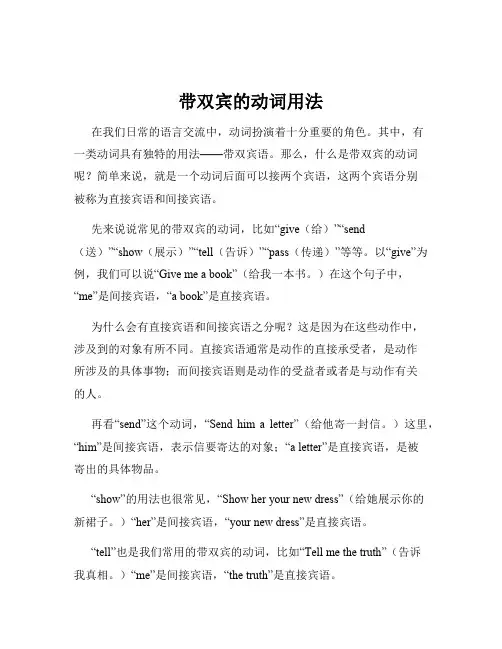
带双宾的动词用法在我们日常的语言交流中,动词扮演着十分重要的角色。
其中,有一类动词具有独特的用法——带双宾语。
那么,什么是带双宾的动词呢?简单来说,就是一个动词后面可以接两个宾语,这两个宾语分别被称为直接宾语和间接宾语。
先来说说常见的带双宾的动词,比如“give(给)”“send(送)”“show(展示)”“tell(告诉)”“pass(传递)”等等。
以“give”为例,我们可以说“Give me a book”(给我一本书。
)在这个句子中,“me”是间接宾语,“a book”是直接宾语。
为什么会有直接宾语和间接宾语之分呢?这是因为在这些动作中,涉及到的对象有所不同。
直接宾语通常是动作的直接承受者,是动作所涉及的具体事物;而间接宾语则是动作的受益者或者是与动作有关的人。
再看“send”这个动词,“Send him a letter”(给他寄一封信。
)这里,“him”是间接宾语,表示信要寄达的对象;“a letter”是直接宾语,是被寄出的具体物品。
“show”的用法也很常见,“Show her your new dress”(给她展示你的新裙子。
)“her”是间接宾语,“your new dress”是直接宾语。
“tell”也是我们常用的带双宾的动词,比如“Tell me the truth”(告诉我真相。
)“me”是间接宾语,“the truth”是直接宾语。
那么,在使用带双宾的动词时,我们需要注意一些什么呢?首先,直接宾语和间接宾语的位置是可以互换的,但需要在间接宾语前加上介词“to”或者“for”。
例如,“Give a book to me”也是正确的表达,但要注意,不是所有带双宾的动词都可以这样互换位置,有些动词只能用“to”,有些只能用“for”,还有些两者都可以。
像“give”“send”“pass”等通常用“to”,比如“Send a letter to him”“Pass the salt to me”而“buy”“make”“cook”等通常用“for”,比如“Buy a present forher”“Make a cake for him”有些动词,像“show”,既可以用“to”也可以用“for”,例如“Show the picture to me”或者“Show the picture for me”其次,要注意在双宾语结构中,宾语的单复数形式要与动词的使用相匹配。
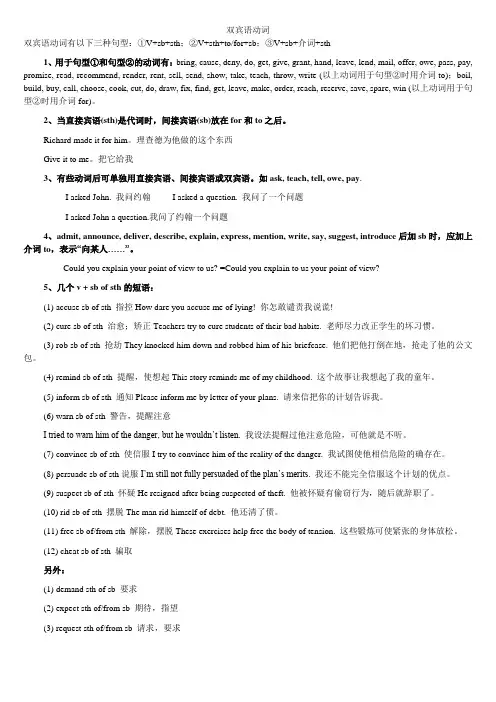
双宾语动词双宾语动词有以下三种句型:①V+sb+sth;②V+sth+to/for+sb;③V+sb+介词+sth1、用于句型①和句型②的动词有:bring, cause, deny, do, get, give, grant, hand, leave, lend, mail, offer, owe, pass, pay, promise, read, recommend, render, rent, sell, send, show, take, teach, throw, write (以上动词用于句型②时用介词to);boil, build, buy, call, choose, cook, cut, do, draw, fix, find, get, leave, make, order, reach, reserve, save, spare, win (以上动词用于句型②时用介词for)。
2、当直接宾语(sth)是代词时,间接宾语(sb)放在for和to之后。
Richard made it for him。
理查德为他做的这个东西Give it to me。
把它给我3、有些动词后可单独用直接宾语、间接宾语或双宾语。
如ask, teach, tell, owe, pay.I asked John. 我问约翰I asked a question. 我问了一个问题I asked John a question.我问了约翰一个问题4、admit, announce, deliver, describe, explain, express, mention, write, say, suggest, introduce后加sb时,应加上介词to,表示“向某人……”。
Could you explain your point of view to us? =Could you explain to us your point of view?5、几个v + sb of sth的短语:(1) accuse sb of sth 指控How dare you accuse me of lying! 你怎敢谴责我说谎!(2) cure sb of sth 治愈;矫正Teachers try to cure students of their bad habits. 老师尽力改正学生的坏习惯。
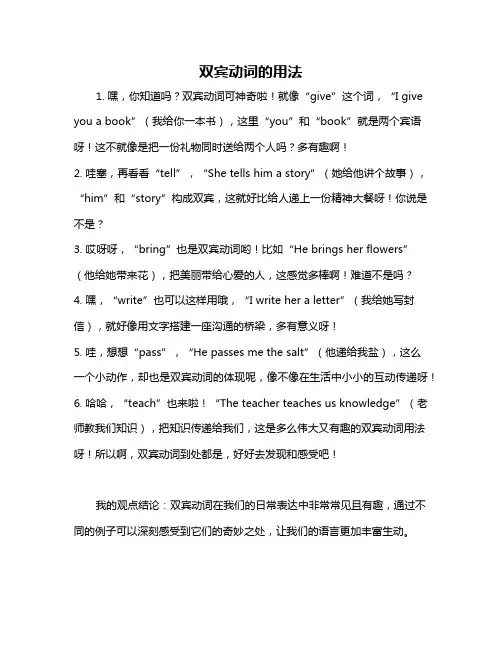
双宾动词的用法
1. 嘿,你知道吗?双宾动词可神奇啦!就像“give”这个词,“I give you a book”(我给你一本书),这里“you”和“book”就是两个宾语呀!这不就像是把一份礼物同时送给两个人吗?多有趣啊!
2. 哇塞,再看看“tell”,“She tells him a story”(她给他讲个故事),“him”和“story”构成双宾,这就好比给人递上一份精神大餐呀!你说是不是?
3. 哎呀呀,“bring”也是双宾动词哟!比如“He brings her flowers”(他给她带来花),把美丽带给心爱的人,这感觉多棒啊!难道不是吗?
4. 嘿,“write”也可以这样用哦,“I write her a letter”(我给她写封信),就好像用文字搭建一座沟通的桥梁,多有意义呀!
5. 哇,想想“pass”,“He passes me the salt”(他递给我盐),这么
一个小动作,却也是双宾动词的体现呢,像不像在生活中小小的互动传递呀!
6. 哈哈,“teach”也来啦!“The teacher teaches us knowledge”(老师教我们知识),把知识传递给我们,这是多么伟大又有趣的双宾动词用法呀!所以啊,双宾动词到处都是,好好去发现和感受吧!
我的观点结论:双宾动词在我们的日常表达中非常常见且有趣,通过不同的例子可以深刻感受到它们的奇妙之处,让我们的语言更加丰富生动。
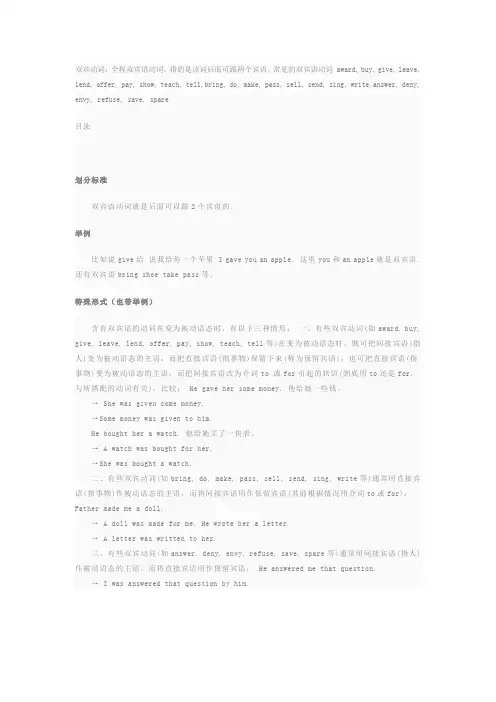
双宾动词,全程双宾语动词。
指的是该词后面可跟两个宾语。
常见的双宾语动词 award, buy, give, leave, lend, offer, pay, show, teach, tell,bring, do, make, pass, sell, send, sing, write,answer, deny, envy, refuse, save, spare目录划分标准双宾语动词就是后面可以跟2个宾语的。
举例比如说give给说我给你一个苹果 I gave you an apple. 这里you和an apple就是双宾语.还有双宾语bring shoe take pass等。
特殊形式(也带举例)含有双宾语的动词在变为被动语态时,有以下三种情形:一、有些双宾动词(如award, buy, give, leave, lend, offer, pay, show, teach, tell等)在变为被动语态时,既可把间接宾语(指人)变为被动语态的主语,而把直接宾语(指事物)保留下来(称为保留宾语),也可把直接宾语(指事物)变为被动语态的主语,而把间接宾语改为介词to 或for引起的状语(到底用to还是for,与所搭配的动词有关)。
比较: He gave her some money. 他给她一些钱。
→ She was given some money.→Some money was given to him.He bought her a watch. 他给她买了一快表。
→ A watch was bought for her.→She was bought a watch.二、有些双宾动词(如bring, do, make, pass, sell, send, sing, write等)通常用直接宾语(指事物)作被动语态的主语,而将间接宾语用作保留宾语(其前根据情况用介词to或for):Father made me a doll.→ A doll was made for me. He wrote her a letter.→ A letter was written to her.三、有些双宾动词(如answer, deny, envy, refuse, save, spare等)通常用间接宾语(指人)作被动语态的主语,而将直接宾语用作保留宾语: He answered me that question.→ I was answered that question by him.1、give, pass, lend, show, send, hand,write和bring8个及物动词,在直接宾语前置时,必须在后面加上“to”。
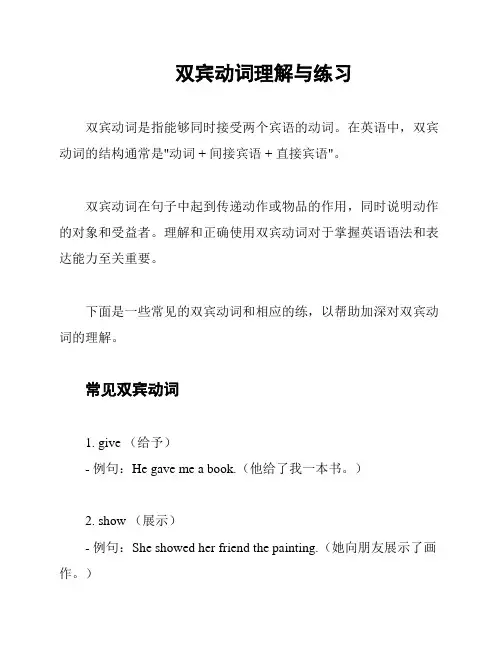
双宾动词理解与练习双宾动词是指能够同时接受两个宾语的动词。
在英语中,双宾动词的结构通常是"动词 + 间接宾语 + 直接宾语"。
双宾动词在句子中起到传递动作或物品的作用,同时说明动作的对象和受益者。
理解和正确使用双宾动词对于掌握英语语法和表达能力至关重要。
下面是一些常见的双宾动词和相应的练,以帮助加深对双宾动词的理解。
常见双宾动词1. give (给予)- 例句:He gave me a book.(他给了我一本书。
)2. show (展示)- 例句:She showed her friend the painting.(她向朋友展示了画作。
)3. send (发送)- 例句:They sent him an email.(他们给他发送了一封电子邮件。
)4. teach (教)- 例句:The teacher taught us English.(老师教我们英语。
)5. buy (买)- 例句:I bought her a gift.(我给她买了一份礼物。
)练1. 请根据句意,填入合适的双宾动词:- He ____________ his mother some flowers.(他给他妈妈买了些花。
)- I will ____________ you a message.(我会给你发一条消息。
)2. 请将以下句子改写成使用双宾动词的形式:- She showed the photos to her friends.- They gave me a present.3. 请根据提供的动词和宾语,构造一个句子:- 动词:teach,宾语:Spanish参考答案1. 练答案:- He bought his mother some flowers.- I will send you a message.2. 改写句子:- She showed her friends the photos.- They gave a present to me.3. 构造句子:- I taught Spanish to her.。

双宾语的句子变被动含有双宾语的动词在变为被动语态时,有以下三种情形:一、有些双宾动词(如award, buy, give, leave, lend, offer, pay, show, teach, tell 等)在变为被动语态时,既可把间接宾语(指人)变为被动语态的主语,而把直接宾语(指事物)保留下来(称为保留宾语),也可把直接宾语(指事物)变为被动语态的主语,而把间接宾语改为介词to 或for引起的状语(到底用to还是for,与所搭配的动词有关)。
比较:He gave her some money. 他给她一些钱。
→ She was given some money.→Some money was given to him.He bought her a watch. 他给她买了一快表。
→ A watch was bought for her.→She was bought a watch.二、有些双宾动词(如bring, do, make, pass, sell, send, sing, write等)通常用直接宾语(指事物)作被动语态的主语,而将间接宾语用作保留宾语(其前根据情况用介词to或for):Father made me a doll.→ A doll was made for me.He wrote her a letter.→ A letter was written to her.三、有些双宾动词(如answer, deny, envy, refuse, save, spare等)通常用间接宾语(指人)作被动语态的主语,而将直接宾语用作保留宾语:He answered me that question.→ I was answered that question by him.双宾语的句子变被动有两种变法。
例:The old man told us a story yesterday.(那位老人昨天给我们讲了一个故事。
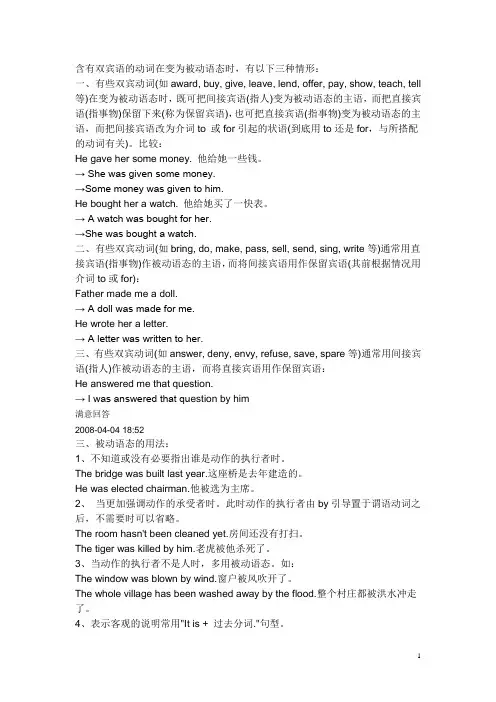
含有双宾语的动词在变为被动语态时,有以下三种情形:一、有些双宾动词(如award, buy, give, leave, lend, offer, pay, show, teach, tell 等)在变为被动语态时,既可把间接宾语(指人)变为被动语态的主语,而把直接宾语(指事物)保留下来(称为保留宾语),也可把直接宾语(指事物)变为被动语态的主语,而把间接宾语改为介词to 或for引起的状语(到底用to还是for,与所搭配的动词有关)。
比较:He gave her some money. 他给她一些钱。
→ She was given some money.→Some money was given to him.He bought her a watch. 他给她买了一快表。
→ A watch was bought for her.→She was bought a watch.二、有些双宾动词(如bring, do, make, pass, sell, send, sing, write等)通常用直接宾语(指事物)作被动语态的主语,而将间接宾语用作保留宾语(其前根据情况用介词to或for):Father made me a doll.→ A doll was made for me.He wrote her a letter.→ A letter was written to her.三、有些双宾动词(如answer, deny, envy, refuse, save, spare等)通常用间接宾语(指人)作被动语态的主语,而将直接宾语用作保留宾语:He answered me that question.→ I was answered that qu estion by him满意回答2008-04-04 18:52三、被动语态的用法:1、不知道或没有必要指出谁是动作的执行者时。
The bridge was built last year.这座桥是去年建造的。
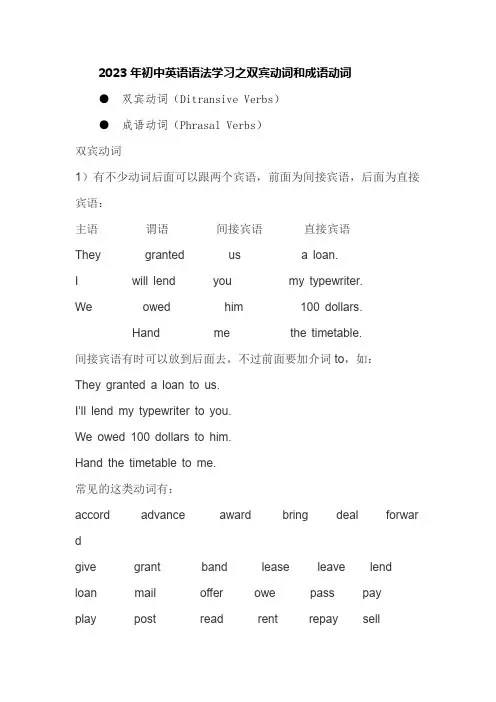
2023年初中英语语法学习之双宾动词和成语动词●双宾动词(Ditransive Verbs)●成语动词(Phrasal Verbs)双宾动词1)有不少动词后面可以跟两个宾语,前面为间接宾语,后面为直接宾语:主语谓语间接宾语直接宾语They granted us a loan.I will lend you my typewriter.We owed him100 dollars.Hand me the timetable.间接宾语有时可以放到后面去,不过前面要加介词to,如:They granted a loan to us.I’ll lend my typewriter to you.We owed 100 dollars to him.Hand the timetable to me.常见的这类动词有:accord advance award bring deal forwar dgive grant band lease leave lend loan mail offer owe pass payplay post read rent repay sellsend serve show sing take teachtell write2)另有一批动词,也可跟两个宾语,但把间接宾语放在后部时,要改为由for引导的短语,如:跟两个宾语包含for引导的短语Sing us a song, please.Please sing a song for us.Father bought me a camera.Father bought a ca mera for me.Fetch me the evening paper.Fetch the evening p aper for me.Play us some light music.Play some light music for us.这类动词常见的有:book bring build buy cook cutdesign fetch find fix get leavemake mix order paint pick playprepare reserve save set sing spare3)还有少数动词也跟两个宾语,但很少把间接宾语放到句子后面去:(1) I’ll never forgive you that lie. 我永远不会原谅你那次撒谎。
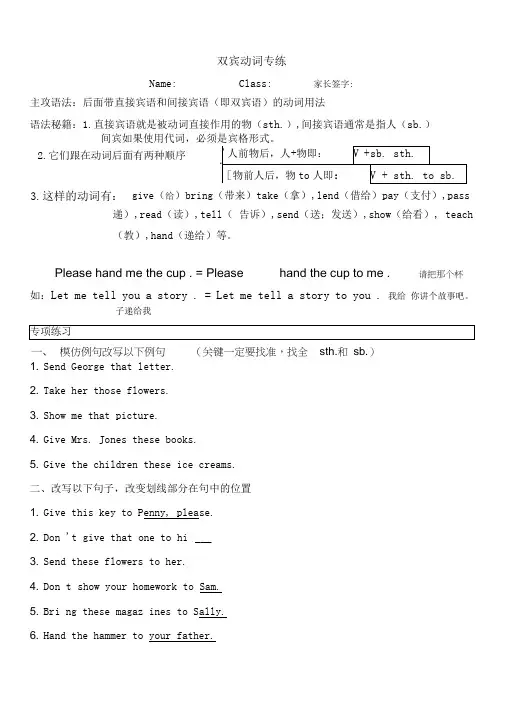
Please hand me the cup . = Pleasehand the cup to me . 请把那个杯 模仿例句改写以下例句(关键一定要找准,找全 sth.和 sb.) 双宾动词专练Name: Class: 家长签字:主攻语法:后面带直接宾语和间接宾语(即双宾语)的动词用法语法秘籍:1.直接宾语就是被动词直接作用的物(sth.),间接宾语通常是指人(sb.) 间宾如果使用代词,必须是宾格形式。
2.它们跟在动词后面有两种顺序 J'人前物后,人+物即: V + s b. sth.[物前人后,物to 人即: V + sth. to sb.3.这样的动词有: give (给)bring (带来)take (拿),lend (借给)pay (支付),pass递),read (读),tell ( 告诉),send (送;发送),show (给看), teach (教),hand (递给)等。
如:Let me tell you a story . = Let me tell a story to you . 我给 你讲个故事吧。
子递给我专项练习1. Send George that letter.2. Take her those flowers.3. Show me that picture.4. Give Mrs. Jones these books.5. Give the children these ice creams.二、改写以下句子,改变划线部分在句中的位置1. Give this key to Penny, please.2. Don 't give that one to hi ___3. Send these flowers to her.4. Don t show your homework to Sam.5. Bri ng these magaz ines to Sally.6. Hand the hammer to your father.7. Don ' t send these tickets to them.8. Can you lend an En glish book to me?9. Pass the ball to her, please.10. Tell the truth to me.三、汉译英。

含有双宾语的动词在变为被动语态时,有以下三种情形:一、有些双宾动词(如award, buy, give, leave, lend, offer, pay, show, teach, tell等)在变为被动语态时,既可把间接宾语(指人)变为被动语态的主语,而把直接宾语(指事物)保留下来(称为保留宾语),也可把直接宾语(指事物)变为被动语态的主语,而把间接宾语改为介词to 或for引起的状语(到底用to还是for,与所搭配的动词有关)。
比较:He gave her some money. 他给她一些钱。
→She was given some money. →Some money was given to him. He bought her a watch. 他给她买了一快表。
→ A watch was bought for her. →She was bought a watch. 二、有些双宾动词(如bring, do, make, pass, sell, send, sing, write等)通常用直接宾语(指事物)作被动语态的主语,而将间接宾语用作保留宾语(其前根据情况用介词to或for):F ather made me a doll. → A doll was made for me. He wrote her a letter. → A letter was written to her. 三、有些双宾动词(如answer, deny, envy, refuse, save, spare等)通常用间接宾语(指人)作被动语态的主语,而将直接宾语用作保留宾语:He answered me that question. → I was answered that question by him。

双宾语动词to和for口诀导读:我根据大家的需要整理了一份关于《双宾语动词to和for口诀》的内容,具体内容:双宾语动词to和for口诀:七给一带to不少,买画制作for来了。
带双宾语的及物动词,如果把直接宾语置于间接宾语之前,必须在变换时加to或for。
带双宾语动词记忆口诀11个及物动词口诀:“七...双宾语动词to和for口诀:七给一带to不少,买画制作for来了。
带双宾语的及物动词,如果把直接宾语置于间接宾语之前,必须在变换时加to或for。
带双宾语动词记忆口诀11个及物动词口诀:“七给”一“带”to不少,“买”画“制作”for 来了。
说明:1、“七给”(give,pass,lend,write,show,send,hand)和“带”(bring)8个及物动词,在直接宾语前置时,必须在后面加上“to”。
即“vt.+sth.+to+sb.”如:He lent some money to me.类似动词的还有:get,mail,offer,owe(借),pay,promise,read,sell,take,teach,等2、“buy”(买);“draw”(画);“make”(制作)三个动词,在直接宾语前置时,则必须在后边加“for”,构成“vt.+sth.+for+sb.”。
如:Mother bought a new dress for me。
类似的动词还有:build,choose,cook,cut,do,find,fix,leave,order(订购),reach等。
3、当直接宾语是代词时,间接宾语for和to于直接宾语之后Richard made it for him。
理查德为他做的这个东西Give it to me。
把它给我4、有些动词后可单独用直接宾语、间接宾语或双宾语,如ask,teach,tell,owe,pay.I asked John.我问约翰I asked a question.我问了一个问题I asked John a question.我问了约翰一个问题5、suggest,explain,introduce,mention,deliver,announce等动词后必须跟介词to,不能进行直接宾语与间接宾语的转换。
双宾动词讲解与练习一、什么是双宾动词双宾动词是指可以带两个宾语的动词。
宾语是动词的补充成分,表示动作的承受者或影响者。
双宾动词可以同时接受两个宾语,这两个宾语在句子中扮演不同的角色。
二、双宾动词的结构一个双宾动词的基本结构是“主语 + 动词 + 间接宾语 + 直接宾语”。
其中,间接宾语通常是表示人的名词或代词,直接宾语则可以是表示物的名词或代词。
三、常见的双宾动词下面是一些常见的双宾动词及其用法:1. give- 用法1:give sb. sth. 给某人某物- 用法2:give sb. sth. 给某人些东西- 用法3:give sth. to sb. 给某人某物2. show- 用法:show sb. sth. 展示给某人某物 / show sth. to sb. 给某人展示某物3. tell- 用法1:tell sb. sth. 告诉某人某事- 用法2:tell sb. to do sth. 告诉某人做某事4. send- 用法1:send sb. sth. 给某人寄送某物- 用法2:send sth. to sb. 将某物寄送给某人5. bring- 用法1:bring sb. sth. 给某人带来某物- 用法2:bring sth. to sb. 带某物给某人6. write- 用法:write sb. sth. 给某人写信四、练题根据句意,选择合适的双宾动词填空:1. Could you ___________ me your pen?- A) give- B) show- C) tell- D) send2. Can you ___________ the book ___________ me, please? - A) bring / to- B) give / to- C) send / to- D) show / to- A) gave- B) told- C) sent- D) brought4. Please ___________ the letter ___________ your mother.- A) send / to- B) give / to- C) tell / to- D) show / to5. He ___________ her some flowers on her birthday. - A) gave- B) wrote- C) sent- D) brought答案:1. A2. A3. B4. A5. C五、总结通过研究双宾动词的讲解和练,我们了解到双宾动词是指可以带两个宾语的动词。
【英语知识点】如何区分宾补和双宾在双宾语中,能充当间接宾语或是直接宾语的一般是名词或代词。
而在宾补中,能充当宾语补足语成分的则较多,如名词、形容词、副词、介词短语、动词不定式(短语)和分词(短语)。
(1)一些动词后面常跟双宾语,这类动词有give,show,bring,read,pass,lend,tell,leave,teach,write,buy,sing等。
例如:The teacher gives each of them an eraser. 老师给他们每人一块橡皮。
(2)一些动词后面常跟宾语补足语,这类动词有let,see,watch,hear,help,feel,keep,call,make,find,tell,ask,think,want等。
例如:We must keep the classroom clean. 我们必须保持教室清洁。
(1)在双宾语中,两个宾语间的关系比较松散,有的句子去掉其中一个宾语,句子仍然成立。
双宾语一般表示“为谁(for sb.)或给谁(to sb.)……”,即“及物动词+间接宾语+直接宾语”的结构可以改写为“及物动词+直接宾语+for sb.或to sb.”的结构。
例如:Please show me your new book.→Please show your new book to me. 请给我看看你的新书。
(2)宾语和宾语补足语之间关系比较紧密,去掉其中一个成分,句子就不能成立或句意不完整。
而且当名词、形容词、副词、介词短语作宾语补足语时,和宾语之间具有“主系表关系”;当不定式(短语)或分词(短语)作宾语补足语时,和宾语之间具有“主谓关系”。
例如:We will make our country more beautiful.(Our country will be more beautiful.) 我们会让城市更加美丽。
感谢您的阅读,祝您生活愉快。
Lesson 3 Please Send Me a Card★send v. 寄, 送1)+双宾send sth. to sb. /send sb. sth.给某人送(寄)什么东西2)+ 单宾send sb./sth.e.g. send a letter 寄信send the children to bed 打发孩子睡觉句型:1. send /give sb. one’s love同remember sb. to sb. 代sb. 向sb.致意(正式)give one’s regards to sb.2. send for sb./sth 派人去请send/take children to school:take强调某人亲自送;send则是通过第三人去送, 如美国的校车take flowers to his wife 自己送send flowers to his wife 叫店里的人送★postcard n. 明信片两个爆破音在一起,前者失去爆破音。
这里/t/和/k/前者失去爆破音post:n./v. 邮政/寄China Post /post a letter①postbag 邮政包②postbox 邮筒/箱(Br.)mailbox(Am.)③postcode 邮编④postoffice⑤postman (Br.) mailbox (Am.)⑥postmark 邮戳⑦post-free 免付邮资/包邮的⑧post-paid 邮资已付的card 卡片cards 纸牌①a Christmas card ②a birthday card③a get-well card 康复卡④ an identity card (ID card)⑤ a pack of cards 一副扑克牌⑥one’s best/strongest card 王牌/绝招⑦ give sb. one’s card⑧ lay one’s card on the table 摊牌⑨name card /visiting card 名片Here is my name card. (口语常用, 同时伴随着递出的动作)⑩credit card 信用卡cash card 现金卡, 储蓄卡, 工资卡(不能透支的那种)★spoil-spoiled-spoiled (规则变化)spoil –spoilt-spoilt (不…强势v.)v. 使索然无味, 损坏英式英语中多用不规则形式dreamt (Br.)美式英语多用规则形式dreamed (Am.)但过去分词作定语时,不论英美,只用不规则形式 a spoilt child (adj. 被宠坏的)1) vt. 弄坏,损坏,糟蹋The sad news spoiled our weekend.这不幸的消息使我们没能过好周末。
▲带双宾语的动词主语+动词+间接宾语(人)+直接宾语(物)主语+动词+直接宾语(物)+to (for) 间接宾语(人)双宾语是指在一个动词后面可以带两个宾语。
我们通常把代表人的宾语叫做间接宾语,物叫做直接宾语。
常见的双宾语动词award, buy, give, leave, lend, offer, pay, show, teach, tell,bring, do, make, pass, sell, send, sing, write,answer, deny, envy, refuse, save, spare等。
若sth是代词时,不用双宾结构,用for/to。
for和to的用法:1、在英文中,for和to没有严格的区分。
2、可以用中文的概念进行区分:中文中有“给”的意思,用to;to( 表示动作方向)中文中有“为”的意思,用for;或or (表示动作目标)中文中既可以用“给”,又可以用“为”的时候,用to和for均可。
give sb. sth.-give sth. to sb.给某人某物pass sb. sth.=pass sth. to sb.递给某人某物show sb. sth.=show sth. to sb.向某人展示某物lend sb. sth.=lend sth. to sb.借给某人某物fetch sb. sth=fetch sth. for sb给某人取某物promise sb. sth.=promise sth. to sb.向某人承诺某事supply sb. sth.=supply sth. to sb.提供给某人某物provide sb. with sth.=provide sth. for sb.提供给某人某物prove sth. to sb.经某人证实某事offer sb. sth.=offer sth. to sb. 提供给某人某物ask sb. for sth. = ask sth. of sb.要求某人给某物或做某事,寻求present sb. with sth.=present sth. to sb.将某物赠予或交给某人。
带双宾的动词
1. 双宾语易位时需借助介词to的常用动词
award sb. sth. = award sth. to sb. 颁奖给某人
bring sb. sth. = bring sth. to sb. 把某物带给某人hand sb. sth. =hand sth. to sb. 把某物递给某人
lend sb. sth. = lend sth. to sb. 把某物借给某人
mail sb. sth. = mail sth. to sb. 把某物寄给某人
offer sb. sth. = offer sth. to sb. 将某物给某人
owe sb. sth. = owe sth. to sb. 欠某人某物
pass sb. sth. = pass sth. to sb. 把某物递给某人
pay sb. sth. = pay sth. to sb. 付给某人某物(钱)post sb. sth. = post sth. to sb. 把某物寄给某人
read sb. sth. = read sth. to sb. 把某物读给某人听return sb.sth. = return sth. to sb. 把某物还给某人
send sb. sth. = send sth. to sb. 把某物送给某人
sell sb. sth. = sell sth. to sb. 把某物卖给某人serve sb. sth. = serve sth. to sb. 拿某物招待某人
show sb. sth. = show sth. to sb. 拿某物给某人看
take sb. sth. = take sth. to sb. 把某物拿给某人teach sb. sth. = teach sth. to sb. 教某人某物
tell sb. sth. = tell sth. to sb. 告诉某人某情况throw sb. sth. = throw sth. to sb. 把某物扔给某人
write sb. sth. = write sth. to sb. 给某人写信
2、双宾语易位时需借助介词for的常用动词
book sb. sth. = book sth. for sb. 为某人预定某物buy sb. sth. = buy sth. for sb. 为某人买某物choose sb. sth. = choose sth. for sb. 为某人选某物
cook sb. sth. = cook sth. for sb. 为某人煮某物draw sb. sth. = draw sth. for sb. 为某人画某物fetch sb. sth. = fetch sth. for sb. 为某人去取某物find sb. sth. = find sth. for sb. 为某人找到某物fix sb. sth. = fix sth. for sb. 为某人准备某物get sb. sth. = get sth. for sb. 为某人拿来某物make sb. sth. = make sth. for sb. 为某人做某物
order sb. sth. = order sth. for sb. 为某人订购某物
pick sb. sth. = pick sth. for sb. 为某人采摘某物
prepare sb. sth. = prepare sth. for sb. 为某人准备某物
save sb. sth. = save sth. for sb. 为某人留某物
sing sb. sth. = sing sth. for sb. 为某人唱某物(歌)
spare sb. sth. = spare sth. for sb. 为某人让出某物
steal sb. sth. = steal sth. for sb. 为某人偷某物
3、有的动词后接的双宾语易位时,既可用介词to引出间接宾语,也可用介词for引出间接宾语,含义相同。
如bring,play等:
Bring me today’s paper.
= Bring today’s paper to [for] me. 把今天的报纸拿给我。
He played us the record he had just bought.
= He played the record he had just bought for [to] us.
他放了他刚买的唱片给我们听。
4、有的动词后接的双宾语易位时,即可用介词to引出间接宾语,也可用介词for引出间接宾语,含义不同。
如leave等:
They left me no food.
= They left no food for me.他们没给我留一点食物。
My uncle left me a large fortune.
= My uncle left a large fortune to me. 叔叔死后留下一大笔财产给我。
5、而有的动词后接双宾语时,既不能用介词to引出间接宾语,也不能用介词for引出间接宾语。
如allow, ask, cause, charge, cost, forgive, refuse等:
He allows his son too much money. 他给他儿子的钱太多。
He asked me some questions. 他问了我一些问题。
This caused me much trouble. 这给我带来了许多麻烦。
He charged me five dollars for a cup of tea. 他一杯茶向我要了5美元。
His mistake cost him his job. 他的错误让他丢了工作。
I envy you your good luck. 我羡慕你的好运。
They forgave him his rudeness. 他们原谅了他的鲁莽。
He refused her nothing. 她要什么他就给什么。